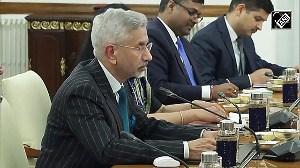Is the Bengali cinema world about to go commercial? An earlier generation of 'art' filmmakers would have shuddered at the very thought.
But today's thoroughly modern moviemakers have bowed to the fact that lucre isn't always filthy -- and that a movie can be a commercial and aesthetic hit at the same time.
Leading the way is Rituparno Ghosh, the new star of Kolkata's cash-starved but influential film world.
Ghosh is raking in the cash for his Chokher Bali made with national level stars like Aishwariya Rai. Chokher Bali cost Rs 1.8 crore (Rs 18 million) which is a king's ransom by the standards of Bengali cinema.
But Ghosh is getting almost instant returns. The Bengal film industry is buzzing with the news that the movie has made Rs 1.25 crore (Rs 12.5 million) within the boundaries of the state.
In addition it quickly made Rs 20 lakh (Rs 2 million) only in Pune and Mumbai. The movie is still showing in north India and returns from the region haven't been accurately calculated yet. On top of this the movie still has the global market to conquer.
Ghosh isn't the only Bengali filmmaker who has discovered that the dynamics of moviemaking have altered in the last few years.
The first print of Buddhadeb Dasgupta's Mondo Meyer Upakhyan cost around Rs 65 lakh (Rs 6.5 million). But it has been sold for $1.5 million to Cinemavault a distributor, which plans to release it in the international markets.
Similarly, Bombaiyer Bombete, directed by Sandip Ray (the son of Satyajit Ray), has been a runaway hit at home and is preparing to hit the national and international markets.
In the movie Sandip has resurrected Feluda, the legendary fictional detective conceived by his father. Bombaiyer Bombete cost around Rs 65 lakh to produce and it recovered the money in the first two weeks. It is currently in its fourth week in Kolkata.
Most interestingly, Bombaiyer Bombete was produced by Ramoji Films, which runs a Bengali entertainment channel ETV.
And the film will be released nationally and in the international markets by Mayuri Films, a marketing wing of Ramoji Films. The company says it will show the film in any place, which has a sizeable Bengali community.
The Ramoji Group isn't the only corporate entity that is turning the camera on the Bengal film industry. The A V Birla has been watching carefully from the sidelines.
Applause Entertainment, the entertainment arm of the Aditya Birla Group, is about to release a Telugu film at the end of January. Its next focus area is Bengal and it is already talking to two major directors in Kolkata.
Anshuman Swamy, CEO, Applause Entertainment reckons it would like to back a film that's somewhere between parallel and commercial cinema like Chokher Bali. Says Swamy: "West Bengal is a potent market for expressing creativity."
Why are quality Bengali films suddenly prospering and even making money? For a start, they are made with the box-office in mind and they have been loved by the audiences.
Over and above that, however, is the fact that audiences are changing and that there are new ways of reaching them.
Take Ghosh's Shubho Mahurat, which is said to have made a princely £12,000 after two shows in the UK. It was also showed a few times in the United States and made $2,000 per show.
On top of that the film has been sold to Britain's Channel Four for a substantial amount.
Now comes the even bigger news that Ghosh is negotiating with Miramax, the Hollywood powerhouse, for the international distribution rights to Chokher Bali.
Ghosh admits cheerfully that he is willing to tailor his movies slightly to fit the new needs of the marketplace. He says that Rai's presence in Chokher Bali helped hugely during negotiations for overseas distribution. Rai has high-profile visibility and everyone who is anyone in the global film world knows who she is.
After all, she is a former Miss World, a jury member at Cannes and a brand ambassador for several multi-national companies. Also, she is playing the lead in Gurinder Chaddha's film Bride and Prejudice.
Ghosh is convinced that national icons like Aishwarya Rai, Sharmila Tagore and Rakhi helped enormously to make his films, Chokher Bali and Shubho Mahurat, more appealing to audiences across India and abroad.
Unlike many other Bengali filmmakers, Ghosh is willing to be flexible in order to sell his films. He will send a shortened version of Chokher Bali for international release. That's because foreign movies are, by and large, shorter than Indian movies and should ideally last around 90 minutes and not more than that.
He also criticises the industry for its old-fashioned way of looking at things. Says Ghosh: "Why do we look at the global market by default, why can't we look global by design and approach it in a strategic way?"
Other industry experts point out that going global isn't always an easy proposition. The film must do the rounds in the right film festivals -- like Berlin, Venice, Cannes -- and catch the attention of the right buyers.
Arindam Mukherjee, managing director, Arjoe Entertainment (which distributed Mondo Meyer Upakhyan) insists that it has been a tough task. "Film festivals are the entry market for films," says Mukherjee.
Once you are there, however, a combination of exchange rates and international pricing ensure that the money comes back quickly. "That is where the money is and it has to be tapped," says Arijit Datta, president, Eastern India Motion Pictures Association.
Dutta, who owns a distribution company and a leading cinema hall in Kolkata says that Bengali films must keep foreign audiences in mind if they want to recover their costs. The problem, he points out, is that Kolkata has only three movie theatres that show quality Bengali films.
Also, the prices of tickets for Bengali films are lower than for English and Hindi movies. Says Datta: "With movie-making budgets shooting up, one has to look at the foreign market to recover costs."
The advent of the multiplex era may make things better for the quality Bengali film industry. Four multiplexes are scheduled to be ready by the middle of 2004. These could improve the commercial viability of quality Bengali films to some extent.
Besides that, Ghosh believes that filmmakers haven't yet been making full use of satellite television. "We must look at selling the films to national television channels at a premium," says Ghosh.
The world is changing rapidly, throwing up new opportunities and challenges. The question is whether the conservative Bengal film world can change with it.




